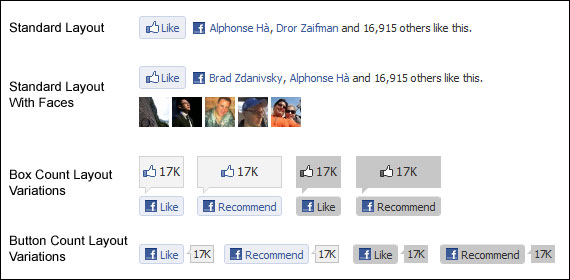How To Convert Website Visitors To Facebook Likes
Because of its intrinsic relationship with the Open Graph protocol, there’s even more compelling reasons to use the Facebook like button than to use the official Tweet button. Like the Tweet button, the Like button is easy to install, and is highly standardized. Furthermore, the Like button is tied directly to Facebook’s analytics platform, Insights, […]
Because of its intrinsic relationship with the Open Graph protocol, there’s even more compelling reasons to use the Facebook like button than to use the official Tweet button.
Like the Tweet button, the Like button is easy to install, and is highly standardized. Furthermore, the Like button is tied directly to Facebook’s analytics platform, Insights, which can provide you with valuable information about each Like button’s performance.
Display Type
The Like button is available in three formats. Standard, which shows the name of a visitor’s friend that has liked the page (if any friends have), and the total number of Likes; button count, which only displays the number of Likes in a compact format; and box count, that shows the number of Likes in a large block above the like icon.
Additionally, photos of the visitor’s friends who have also Liked the resource may be displayed.

Different Facebook Button Layouts and Variations
The same considerations that apply to the Tweet button are at play here, although the Like count is always displayed, so less active websites will probably not want to highlight the small number of Likes by using the box count option or displaying faces.
A light and dark color scheme are available, as well as different fonts; optimizing these may take the form of either closely matching your site’s look and feel, or perhaps trying to improve conversions by using a color scheme and font combination that make the like button stand out.
Positioning
The placement options that apply to the Tweet button are applicable here as well. Ensure that the Like button is placed where users are most likely to click on it in the context of the content, and don’t clutter up short pages with multiple like buttons.
Like vs. Recommend
Facebook provides two label options for the Like button: “Like” and “Recommend.”
That recommendation implies standing more firmly behind something than simply liking it does may discourage some visitors from clicking on a “recommend” button, but it may be the most appropriate verb for some types of content (and may increase other conversions associated with that resource, because it is stronger than “like”). This is definitely something worth testing to maximize the number of likes a page receives.
Liking (& Commenting) vs. Sharing On Facebook
Prior to the introduction of the Like button in April 2010, visitors to a site could post both a link to a comment to their Facebook profile wall by using the Facebook share button (introduced in October 2010).
Some users have continued to employ both the share and Like buttons, both because of the commenting functionality of the share button, and the greater visibility granted to shared items on Facebook.
However, as a result of a February 2011 update to the Like button, Liked items now receive the same visibility on Facebook as shared items, and users are given the option to add a comment to a link once the Like button has been pressed.
For these reasons, and the fact that Facebook is no longer developing the share button, there is no reason to carry both buttons.
From a conversion perspective, the presence of two Facebook buttons with different labels that accomplish basically the same thing is not helpful; if you’re carrying the share button, consider retiring it and using the Like button exclusively.
Read on for other useful tips in this series:
Contributing authors are invited to create content for Search Engine Land and are chosen for their expertise and contribution to the search community. Our contributors work under the oversight of the editorial staff and contributions are checked for quality and relevance to our readers. The opinions they express are their own.
Related stories
New on Search Engine Land